Nuclear Disarmament and Non-Proliferation
 Proliferation Security Initiative (PSI) Maritime Interdiction Exercise "Pacific Shield 18" hosted by Japan
Proliferation Security Initiative (PSI) Maritime Interdiction Exercise "Pacific Shield 18" hosted by Japan
August 13, 2018
- 1. Overview
- 2. Welcome Reception hosted by Parliamentary Vice-Minister for Foreign Affairs Iwao Horii (July 23)
- 3. Academic Session (July 24)
- 4. Live Exercise (LIVEX) (July 25)
- 5. Table Top Exercise (TTX) (July 25)
- 6. Port Exercise (PORTEX) (July 26)
- 7. Capacity Building Program (led by the United States) (July 22-27)
1. Overview
(1) Dates and Venues:
- Dates: July 24-26, 2018
[note] The capacity building program was held from July 22 to July 27. - Venues: Yokosuka City, off Boso Peninsula and Izu Peninsula, etc.
(2) Participating Countries (6 countries in the Asia-Pacific Exercise Rotation (APER)):
Japan (Ministry of Foreign Affairs, National Police Agency, Ministry of Finance (Japan Customs), Japan Coast Guard, Ministry of Defense, etc.), Australia, New Zealand, the Republic of Korea, Singapore, and the United States
(3) Observer Countries (19 countries):
- Operational Experts Group (OEG) members (8 countries):
- Canada, France, Greece, Italy, Netherlands, Norway, Poland, and Russia
- PSI-endorsing countries in the Asia-Pacific (6 countries):
- Brunei, Cambodia, Malaysia, the Philippines, Thailand, and Viet Nam
- Non PSI-endorsing countries in the Asia-Pacific (5 countries):
- India, Laos, Maldives, Myanmar, and Pakistan
(4) Background:
Pacific Shield 18 was held as the fifth iteration of the Asia-Pacific Exercise Rotation (APER), which was created at the PSI 10th Anniversary High Level Political Meeting in 2013.
It was also the fourth PSI exercise hosted by Japan, following maritime interdiction exercises Team Samurai 04 (October 2004) and Pacific Shield 07 (October 2007) and air interdiction exercise Pacific Shield 12 (July 2012).
(5) Objectives:
- To enhance capabilities and cooperation in the Asia-Pacific region to counter proliferation of weapons of mass destruction (WMD)
- To promote understanding of PSI activities
- To conduct outreach to non PSI-endorsing countries
2. Welcome Reception hosted by Parliamentary Vice-Minister for Foreign Affairs Iwao Horii (July 23)
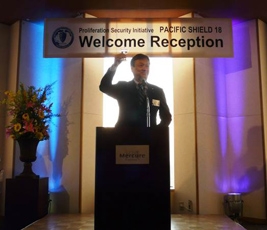
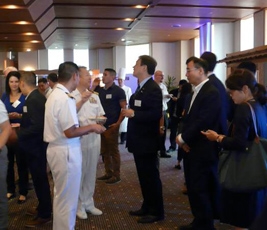
- (1) Venue:
- Hotel in Yokosuka City
- (2) Participants:
- Representatives from APER and observer countries; Mayor Katsuaki Kamiji of Yokosuka City, etc. (Approximately 150 participants)
- (3) Summary:
- In his welcome remarks, Parliamentary Vice-Minister Iwao Horii expressed his strong hope that this exercise will advance PSI objectives by enhancing capacity and cooperation across the region, raising awareness among participants, and demonstrating participating countries' strong commitment. Mr. Horii also stated that Japan, through inter-agency cooperation, will work with PSI partners in the years ahead to further promote international peace and security.
3. Academic Session (July 24)
 Opening Remarks by Ambassador Masahiro Kawasaki
Opening Remarks by Ambassador Masahiro Kawasaki
- (1) Venue:
- Hotel in Yokosuka City
- (2) Participants:
- Representatives from APER and observer countries
- (3) Summary:
- Experts from APER countries provided presentations on PSI activities and non-proliferation issues.
4. Live Exercise (LIVEX) (July 25)
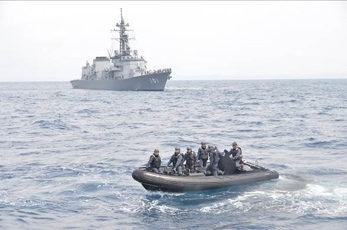 Boarding Exercise by JMSDF
Boarding Exercise by JMSDF
 Boarding Exercise by JMSDF
Boarding Exercise by JMSDF
- (1) Venue:
- Off Boso Peninsula and Izu Peninsula
- (2) Participants:
- Japan (Ministry of Foreign Affairs and Ministry of Defense), Australia, the Republic of Korea, and the United States
- (3) Summary:
-
- A. LIVEX-Air (Australia, Japan, and the United States)
- Patrol aircraft AP-3C from the Royal Australian Air Force, P-1 from the Japan Maritime Self-Defense Force (JMSDF), and P-8 from the U.S. Navy conducted an exercise on searching a suspect vessel and sharing the information.
-
 (From left to right) Participants and aircraft from the United States,
(From left to right) Participants and aircraft from the United States,
Australia, and Japan
- B. LIVEX-Sea (Japan, the Republic of Korea, and the United States)
- Destroyer Murasame and a boarding team from JMSDF, USS Milius from the U.S. Navy, a boarding team from the U.S. Coast Guard (USCG), and a boarding team from the Republic of Korea Coast Guard (ROKCG) conducted an exercise as follows:
-
- -Destroyer Murasame found a suspect vessel and asked it to stop and cooperate with inspection.
- -Destroyer Murasame dispatched a boarding team, which then embarked the suspect vessel and searched the vessel for suspect materials.
- -USCG and ROKCG boarding teams each embarked the suspect vessel from USS Milius and searched the vessel for suspect materials.
5. Table Top Exercise (TTX) (July 25)
 Table Top Exercise
Table Top Exercise
- (1) Venue:
- Hotel in Yokosuka City
- (2) Participants:
- Representatives from APER countries, including Japan (Ministry of Foreign Affairs, National Police Agency, Japan Coast Guard, and Ministry of Defense), and observer countries
- (3) Summary:
- Participants conducted a table top simulation based on a fictional WMD proliferation scenario to examine national decision-making and multilateral cooperation for taking counter-proliferation measures.
6. Port Exercise (PORTEX) (July 26)
- (1) Venue:
- Kurihama Pier at the Port of Yokosuka
- (2) Participants:
- Japan (Ministry of Foreign Affairs, National Police Agency, Ministry of Finance (Customs), Japan Coast Guard, Ministry of Defense), the United States (Coast Guard, Customs and Border Protection, Army, Marine Corps, Nevada National Guard), Republic of Korea Army, Philippine Army, and Royal Thai Army
- (3) Summary:
-
- A. Exercise by Japanese law enforcement agencies
- A joint inspection team from the Kanagawa Prefectural Police, Yokohama Customs, and Japan Coast Guard conducted an exercise for the on-board inspection of a suspect vessel and the inspection of a suspect cargo containing chemical materials.
-
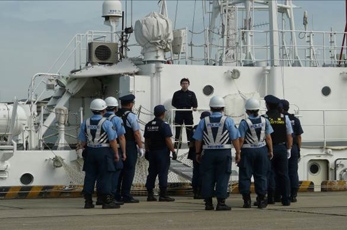 On-board inspection of a suspect vessel
On-board inspection of a suspect vessel Inspection of suspect material by X-ray inspection vehicle
Inspection of suspect material by X-ray inspection vehicle
 Cargo inspection by Kanagawa Prefectural Police
Cargo inspection by Kanagawa Prefectural Police Detection of suspect material by Kanagawa Prefectural Police
Detection of suspect material by Kanagawa Prefectural Police
- B. Exercise by Kanagawa Prefectural Police and Japan Ground Self-Defense Force (JGSDF)
- Kanagawa Prefectural Police Counter NBC (nuclear, biological, and chemical) Terrorism Special Team and JGSDF NBC Team demonstrated the detection and decontamination of chemical materials.
-
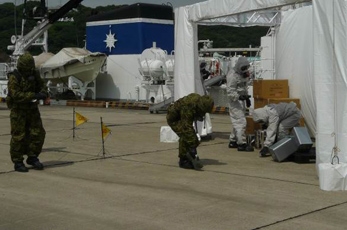 Detection by Kanagawa Prefectural Police
Detection by Kanagawa Prefectural Police
Counter NBC Terrorism Special Team and
JGSDF NBC Team Decontamination by JGSDF NBC Team
Decontamination by JGSDF NBC Team
- C. Joint Exercise by the United States, the Republic of Korea, the Philippines and Thailand
- A joint team from the United States, the Republic of Korea, the Philippines and Thailand conducted the on-board inspection of a suspect vessel and the inspection of a suspect cargo containing radioactive materials at the port, as part of the capacity building program for the Philippines and Thailand.
-
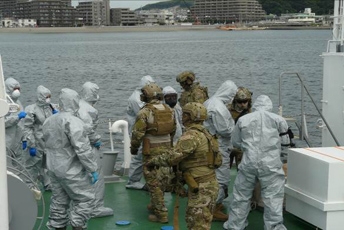 On-board inspection of a suspect vessel by the joint team
On-board inspection of a suspect vessel by the joint team Participants of joint exercise
Participants of joint exercise
7. Capacity Building Program (led by the United States) (July 22-27)
 Participants in the Capacity Building Program
Participants in the Capacity Building Program
- (1) Venue:
- Hotel in Yokosuka City, Kurihama Pier at the Port of Yokosuka, and JGSDF Chemical School
- (2) Participants:
- Japan (Ministry of Foreign Affairs, Ministry of Defense), the United States (Coast Guard, Customs and Border Protection, Army, Marine Corps, Nevada National Guard), Australian Department of Defence, Republic of Korea Army, Philippine Army, and Royal Thai Army
[note] Representatives from Malaysia joined the program as observers. - (3) Summary:
- The United States, Australia, the Republic of Korea, and Japan provided presentations and hands-on training for representatives from the Philippines and Thailand on the detection of radioactive materials. On July 27, the participants visited the JGSDF Chemical School to conduct the training on detection and decontamination.


 (214KB)
(214KB)